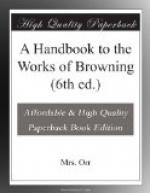The former represents an angel, standing with outstretched wings by a little child. The child is half kneeling on a kind of pedestal, while the angel joins its hands in prayer: its gaze directed upward towards the sky, from which cherubs are looking down. The picture was painted by Guercino, and is now in the church of St. Augustine, at Fano, on the Italian coast. Mr. Browning relates to an absent friend (who appears in the “Dramatic Romances” as Waring) how he saw it in the company of his own “angel;” and how it occurred to him to develop into a poem one of the thoughts which the picture had “struck out.” The thought resolves itself into a feeling: the yearning for guidance and protection. The poet dreams himself in the place of that praying child. The angel wings cover his head: the angel hands upon his eyes press back the excess of thought which has made his brain too big. He feels how thankfully those eyes would rest on the “gracious face” instead of looking to the opening sky beyond it; and how purely beautiful the world would seem when that healing touch had been upon them.
The second was painted by F. Leighton. It represents Orpheus leading Eurydice away from the infernal regions, but with an implied variation on the story of her subsequent return to them. She was restored to Orpheus on the condition of his not looking at her till they had reached the upper world; and, as the legend goes, the condition proved too hard for him to fulfil. But the face of Leighton’s Eurydice wears an intensity of longing which seems to challenge the forbidden look, and make her responsible for it. The poem thus interprets the expression, and translates it into words.
“ANDREA DEL SARTO” ("Men and Women,” 1855) lays down the principle, asserted by Mr. Browning as far back as in “Sordello,” that the soul of the true artist must exceed his technical powers; that in art, as in all else, “a man’s reach should exceed his grasp.” And on this ground the poem might be classed as critical. But it is still more an expression of feeling; the lament of an artist who has fallen short of his ideal—of a man who feels himself the slave of circumstance—of a lover who is sacrificing his moral, and in some degree his artistic, conscience to a woman who does not return his love. It is the harmonious utterance of a many-sided sadness which has become identified with even the pleasures of the man’s life; and is hopeless, because he is resigned to it.
Andrea del Sarto was called the “faultless painter.” His execution was as easy as it was perfect; and Michael Angelo is reported to have said to Raphael, of the insignificant little personage Andrea then was: that he would bring the sweat to his (Raphael’s) brow, if urged on in like manner by popes and kings. But he lacked strength and loftiness of purpose; and as Mr. Browning depicts him, is painfully conscious of these deficiencies. He feels that even an ill-drawn picture of Raphael’s—and




